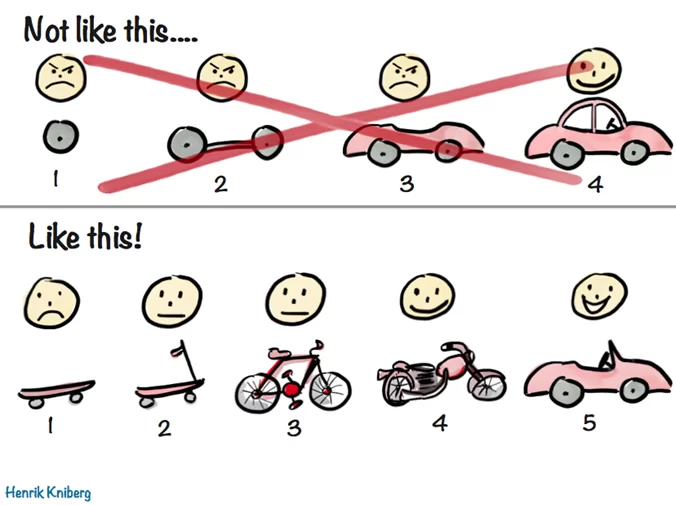AI/ML
Agile Manifesto’s 12 Principles in Action in the 2023 Work Environment
Agile refers to various frameworks and approaches to value delivery in complex environments.
The term became popular after the Agile Manifesto was formed in 2001 by a group of 17 software practitioners who were looking for a better way to deliver software. They wanted to refer to their more rational and human approach to complex work and settled on the term “agile” for this purpose.
Even 22 years after its invention, Agile is still a fundamental software development approach. Its principles are relevant in the current software development environment. Organizations like us rely on these principles to ensure our processes are efficient and focused on customer goals.
In this article, we’ll discuss how every principle of Agile is relevant to our daily business operations.
12 Principles of Agile Manifesto
- Our highest priority is to satisfy the customer through early and continuous delivery of valuable software.
- Welcome changing requirements, even late in development. Agile processes harness change for the customer’s competitive advantage.
- Deliver working software frequently, with a preference to the shorter timescale.
- Business people and developers must work together daily throughout the project.
- Build projects around motivated individuals. Give them the environment and support they need, and trust them to get the job done.
- The most efficient and effective method of conveying information to and within a development team is face-to-face conversation.
- Working software is the primary measure of progress.
- Agile processes promote sustainable development. The sponsors, developers, and users should be able to maintain a constant pace indefinitely.
- Continuous attention to technical excellence and good design enhances agility.
- Simplicity–the art of maximizing the amount of work not done–is essential.
- The best architectures, requirements, and designs emerge from self-organizing teams.
- At regular intervals, the team reflects on how to become more effective, then tunes and adjusts its behavior accordingly.
How the 12 Principles of Agile Manifesto Work in Real Operations
Let’s take one principle at a time.
1. Prioritizing customer satisfaction
This principle emphasizes putting the customer first and delivering value quickly and frequently. It recognizes that the primary goal of software development is to meet the customer’s needs and deliver software that provides value to them.
Here is a very popular image that illustrates this principle very well.

To implement this principle in everyday work environments, teams can focus on delivering working software in smaller, more valuable increments instead of waiting until the end of the project.
The goal is that the customer should find your deliverables valuable. It is an incremental approach where teams continuously figure out the most valuable thing to do next rather than envisioning the end state of a product and working on that step-by-step.
2. Welcoming Requirement Changes
This principle acknowledges that requirements can change throughout the development process and encourages teams to embrace those changes.
It recognizes that adapting to changing requirements is critical to delivering software that meets the customer’s needs and provides them with a competitive advantage.
To implement this principle in everyday work environments, teams can stay flexible and open to new ideas. They can ensure that all team members are aware of any changes made to the requirements and adapt quickly.
This can be done by conducting regular meetings and ensuring communication between team members and stakeholders to ensure everyone is on the same page. Delivering value in smaller, usable increments also makes it possible for teams to incorporate change.
Another actionable is that teams shouldn’t plan for the entire project at once initially. Instead, they should plan frequently.
Teams can also use agile processes such as Scrum or Kanban to accommodate changes. These processes provide a framework for managing and prioritizing work, which can help teams stay focused and adapt to changes in requirements.
3. Frequent Delivery of Working Software Every Week or Month
All Agile frameworks rely on the principle of delivering working software frequently. However, this principle requires teams to deliver working software, not just a cog in the machine.
To implement this principle in everyday work environments, teams can use an iterative and incremental approach to software development. They can break the work into smaller, manageable sprints and deliver working software at the end of each iteration.
Here, the sprint length should be enough to let developers deliver a usable product increment. Additionally, the teams should prefer a shorter timeframe.
4. Collaboration Among Business People and Developers
This principle highlights the importance of collaboration between business people and developers.
In a traditional approach, the delivery team often goes through a long and intense requirements phase where they meet with the business stakeholders. However, after completing the requirements phase, the delivery team disappears to build whatever they understand. This often results in the development of software quite different from what the client intended.
On the other hand, businesspeople and developers can work together to define the scope and requirements of the project. By working together from the beginning, they can ensure that the software being developed is aligned with the business goals and objectives.
To implement this principle in everyday work environments, teams can establish clear lines of communication between business people and developers.
They can hold regular meetings, such as daily stand-up meetings or sprint reviews, to ensure everyone is on the same page and that any issues are addressed on time.
5. Motivate Individuals and Build Trust
This principle emphasizes creating an environment where motivated individuals can thrive. It recognizes that motivated individuals are the driving force behind successful software development projects and that providing them with the right environment and support is critical to their success.
To implement this principle in everyday work environments, teams can focus on creating a supportive and collaborative culture. This can be done by providing team members with the necessary resources to do their jobs effectively, such as training, equipment, and support.
Teams can also create a culture of trust, where team members are empowered to make decisions and take ownership of their work. This can be done by delegating responsibility and providing opportunities for team members to contribute meaningfully to the project.
6. Prioritize Face-to-Face Conversations
This principle highlights the importance of communication in software development. It recognizes that F2F conversations are often the most efficient and effective way to convey information.
With the adoption of Zoom and other professional meeting platforms, the words F2F have taken on a slightly different meaning lately. However, the idea behind this principle remains.
To implement this principle in everyday work environments, teams can focus on creating opportunities for F2F communication. This can be done by holding regular team meetings, such as daily stand-up meetings or sprint retrospectives, where team members can discuss progress, issues, and ideas.
In addition to F2F communication, teams can use visual aids, such as whiteboards or sticky notes, to help convey information and keep everyone informed.
7. Working Software Delivery
The Agile approach deems the delivery of a functional product as the ultimate success metric, prioritizing usability above all else. While progress reports may hold value, they are not an end goal in themselves. Ultimately, the focus is on producing a tangible, usable product.
To implement this principle in everyday work environments, teams can focus on delivering working software in small, iterative increments. This approach, often called “incremental delivery” or “iterative development,” allows teams to deliver functional software early and frequently rather than waiting until the end of the project for delivery.
8. Maintain a Constant Pace
This principle suggests that software development is a marathon, not a sprint. It acknowledges that teams need to work at a sustainable pace over the long term rather than pushing for short-term gains at the expense of long-term productivity.
To implement this principle in everyday work environments, teams can focus on maintaining a consistent, sustainable pace of work over time. This can be done by avoiding overcommitting to unrealistic deadlines or taking on too much work simultaneously.
9. Technical Excellence and Good Design for Agility
As per this principle, Agile teams need to prioritize delivering high-quality products, which entails focusing on feature development and tackling any existing technical debt, and preventing its accumulation.
When working with the Scrum framework, Agile teams can collaborate with the Product Owner to add items that enhance product quality to the Product Backlog.
Additionally, by implementing best practices such as regular code reviews and adhering to security standards, teams can establish a Definition of Done that helps prevent the accidental accumulation of technical debt.
10. Work on the Essential Elements Only
It highlights that complexity can be a major barrier to productivity and that teams should focus on doing only the necessary work to achieve the desired outcome.
Agile teams should break down tasks into smaller, more manageable pieces and prioritize work that delivers the most value to the customer.
Teams should also avoid over-engineering solutions and focus on developing the simplest solution that meets the business requirements. This can reduce the risk of introducing unnecessary complexity and make it easier to modify the software over time.
11. Self-Organizing Teams Deliver the Best
This principle underlines empowering teams to make decisions and self-organize to achieve their goals.
In an agile environment, the teams should have the power to decide how to approach their work and solve problems as they arise. The team members should be encouraged to collaborate and innovate and to support continuous improvement.
Self-organizing teams are more likely to be motivated, engaged, and productive, and they can better adapt to changing circumstances.
It’s important to give team members the resources and support they need to be successful. This includes providing the tools and information they need to make informed decisions. Also, give them the autonomy to experiment and try new things.
Leaders should also be willing to step back and let the team take ownership of their work, providing guidance and support when needed.
12. Teams Should Become Effective Overtime
This principle underscores that Agile is a continuous improvement process, and teams should constantly look for ways to improve their processes, tools, and techniques.
So, creating a culture of reflection and continuous improvement is important. This can be achieved through regular retrospectives, where the agile teams come together to discuss what went well, what didn’t, and what changes they can make to improve.
Team leaders should also be willing to listen to feedback and make changes based on the team’s input.
Bottom Line: Agile Will Continue to Be the Central Force
In conclusion, the Agile Manifesto’s 12 principles provide a framework for delivering value in complex and rapidly changing environments.
By embracing individual interactions, working software, customer collaboration, and responding to change, organizations can create a culture of agility that enables them to adapt to changing circumstances and deliver value to their customers.
Software development teams worldwide are already using Agile to keep delivering better products. And this trend will continue.
Innovify is putting the 12 principles for Agile development into action in their 2023 work environment by prioritizing customer satisfaction, embracing change, and fostering collaboration among team members. This approach allows them to deliver high-quality products and services while remaining adaptable to evolving market conditions.
FAQs
1. How are the 12 principles of Agile Manifesto different from traditional project management practices?
Agile project management focuses on continuous improvement, delivering working software frequently, and embracing change. In contrast, traditional project management follows a more structured, linear approach and is less flexible in dealing with change. Agile emphasizes the importance of collaboration, teamwork, and customer satisfaction, while traditional project management may emphasise meeting predefined requirements and following established procedures.
2. What are the benefits of using the 12 principles of Agile Manifesto in project management?
Agile project management helps teams be more flexible, adaptive, and responsive to changes in requirements or priorities. By breaking down projects into smaller iterations, teams can deliver value more frequently and get feedback from stakeholders early in the process. This approach also fosters a collaborative and transparent work environment, which helps build trust and improve communication among team members and stakeholders.
3. What challenges can arise when using the 12 principles of Agile Manifesto in project management?
One challenge with Agile project management is that estimating how long each iteration or task will take can be difficult, making it challenging to plan and track progress. Additionally, emphasising collaboration and teamwork may require more time and effort for communication and coordination. Finally, it can be difficult to balance the need for flexibility with the need to maintain project timelines and budgets.
4. How can teams successfully implement the 12 principles of Agile Manifesto in project management?
To successfully implement the 12 principles of Agile Manifesto, teams should start by adopting an Agile mindset and culture, which includes a willingness to embrace change, experiment, and learn from mistakes. Effective communication, collaboration, and trust are essential, as is a focus on delivering value to customers through working software. Teams should also regularly reflect on their processes and make necessary adjustments to improve continuously. Finally, choosing the appropriate Agile framework and tools for your team’s specific needs and context is important.
5. What is the purpose of the 12 principles of Agile Manifesto?
The purpose of the Agile Manifesto 12 principles is to guide project management teams in developing and delivering software in an agile, flexible, and collaborative manner that prioritizes customer satisfaction, continuous improvement, and adaptation to change.




